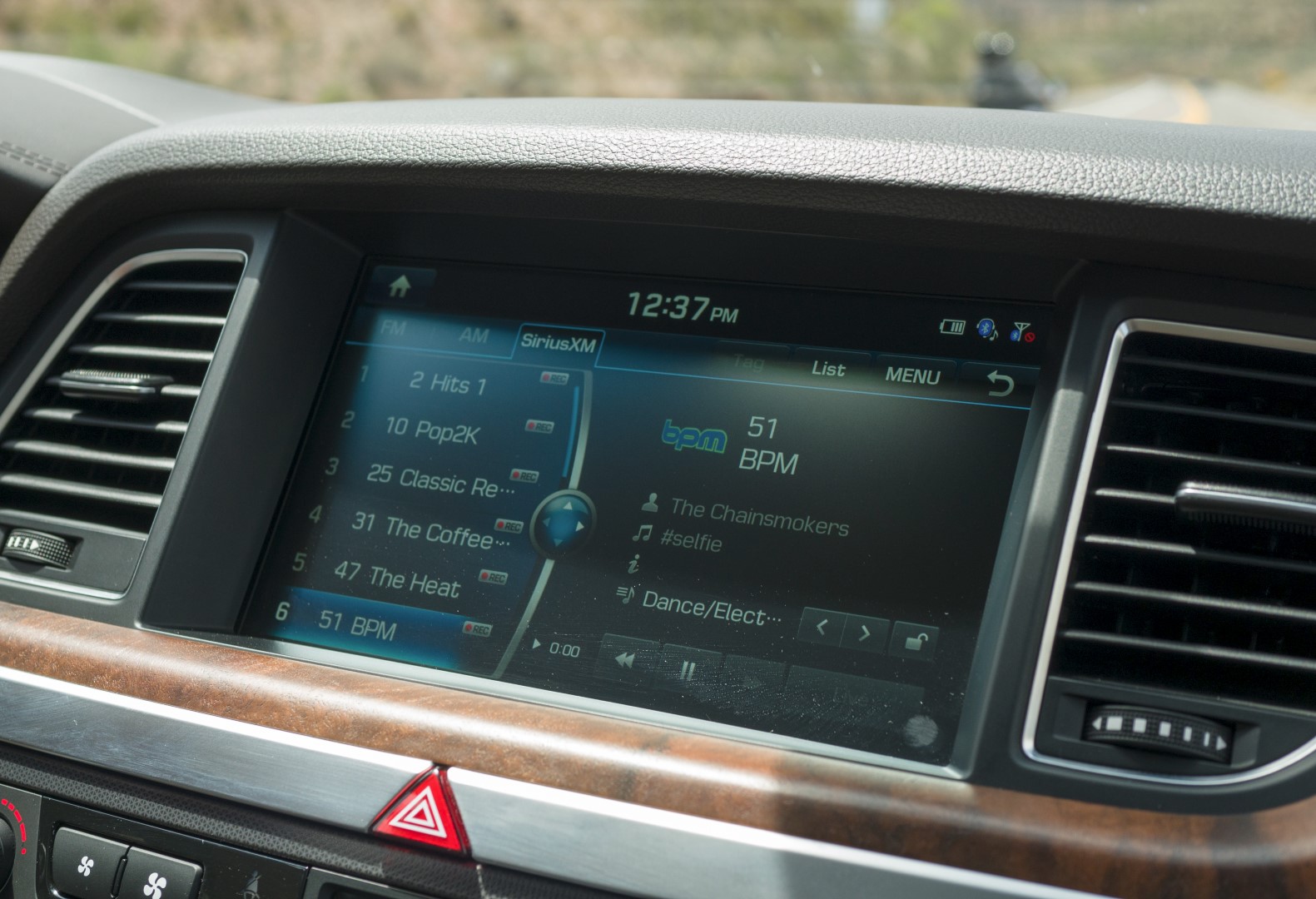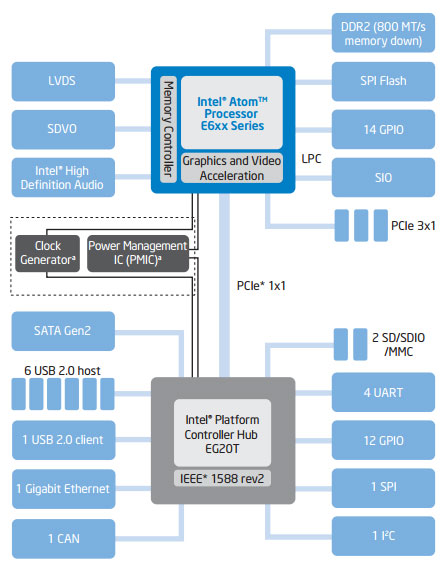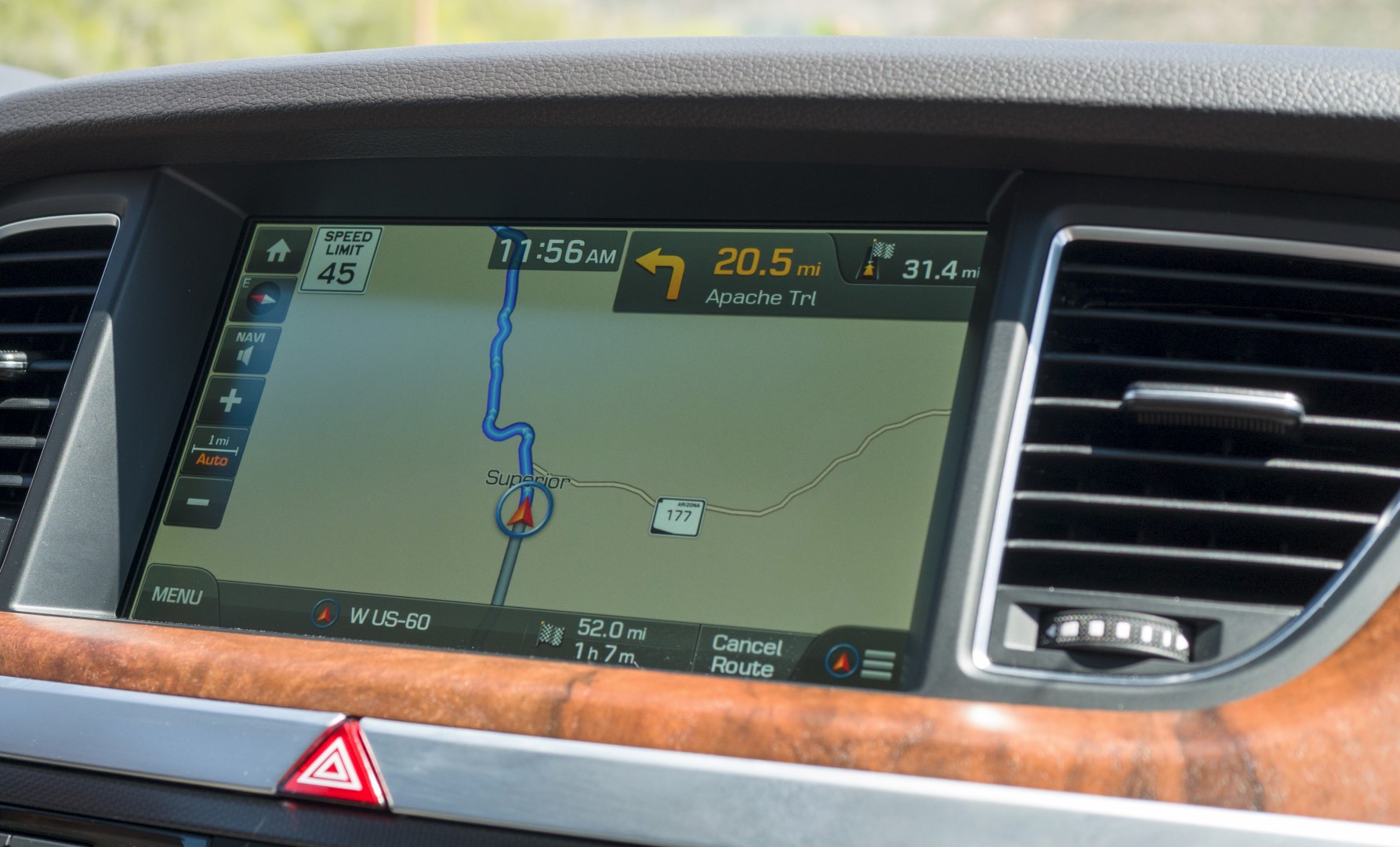2015 Hyundai Genesis Sedan: Android, Atom, And More
Hyundai is updating its luxury sedan with a new platform and design for 2015. We flew out to Arizona for a first drive of the 2015 Genesis.
Optional Intel Atom Infotainment System
Buyers that opt for the Ultimate Package upgrade the pure touch screen infotainment to a dual interface system which Hyundai calls DIS (Driver Information System) 2.0. The premium system maintains the touch screen interface, but adds a control knob which is similar to the one in the company's flagship Equus. The control knob is located on the center console and below the shifter gate. As with our experience in the Equus, Hyundai chose to use similar positioning for the control knob, which makes it awkward and uncomfortable to use.
The biggest upgrade with the DIS 2.0 system is a bigger 9.2-inch display. While its only 1.2-inches bigger than the base AVN 4.5 display, the resolution receives a bump up to high-definition 720p, and it looks excellent from the driver’s seat. The entire user interface is clean and crisper than other infotainment displays we’ve come across. However, the higher resolution display and control knob come with one caveat, you must give up the Android-based OS.
Instead, another Linux-based OS takes center stage on DIS 2.0. This time Hyundai dug up Meego from the smartphone OS cemetery and tweaked it for automotive use. The use of Meego might sound odd for those of us used to reading about smartphones and tablets, but it’s the official OS for GENIVI, which is an alliance of automotive manufacturers and suppliers with the goal of driving mass adoption of open source infotainment systems.
Powering the Meego-powered DIS 2.0 system is an Intel Atom processor. No, it’s not the latest dual or quad-core Bay Trail, those embedded processors are simply too new. Instead, its Tunnel Creek, which itself is based on Moorestown, but optimized for embedded applications. Intel announced the single-core Atom at IDF 2010, which seems like an old dinosaur by PC hardware standards, but the embedded and automotive market have different development cycles. Tunnel Creek was most likely the latest and greatest available from Intel at the start of the DIS 2.0 development.
Graphics for the Atom E660 is what Intel calls GMA 600. Despite what Intel calls it, the graphics core is based on the PowerVR SGX 535, much like the earlier GMA 500 found in Poulsbo, or the Atom Z5xx series. However, GMA 600 doubles the clock speed to 400 MHz from the GMA 500 for a bit more GPU power. Regardless, the GMA 600 is perfectly adequate, if not overkill for automotive infotainment use.
Hyundai did not provide us with the specific Intel Atom used but provided the clock speed. The 1.3 GHz enabled us to narrow it down to the Atom E660 series. Intel offers two chips in that series with the standard E660 and E660T. The only difference between the regular and T variant is a maximum operating die temperate of 110 C on the E660T versus 90 C on the E660. Otherwise, both processors have maximum TDPs of 3.6 watts, HyperThreading technology, 512KB of L2 cache, DDR2 memory interface, and are fabricated on a 45nm process. Since temperatures can vary greatly in a vehicle depending on the region where it’s driven, we predict Hyundai opted for the Atom E660T for that extra 20 C of thermal headroom.
The premium DIS 2.0 infotainment system also comes with a 64 GB SSD for storage. Hyundai leaves 30 GB of free space for drivers to copy their own music and images. Since I forgot to grab a USB flash drive from my car on the way to the airport, we didn’t get to test the feature on the 2015 Genesis sedan. However, we expect it to function the same way as the first generation DIS system in the Equus, which can only copy music from a USB device, and not a retail music CD.
Get Tom's Hardware's best news and in-depth reviews, straight to your inbox.
All the vehicles on hand at the launch event had DIS 2.0. We drove over 200 miles with the system and found it pretty good. The UI is responsive, the music functions are easy to use, navigation maps were 2D but had good detail, and there weren’t too many lock outs as long as you agree to the disclaimer every time the vehicle starts. There were lock outs for the Blue Link apps while the vehicle is in motion though.
Hyundai touted Pandora and Aha radio support, but that is only available to iOS users who plug in their phones via the Genesis’ USB port. We were told Android might be a possibility in the future but there’s no solid launch date. As the other journalist I was paired with and I had Google Nexus 5 phones, we were unable to test the streaming Internet radio features. However, we were out of reception areas for most of the drive anyway. Apple iOS users do get Siri Eyes Free support as well, but we did not get to play with that functionality either.
(Update: Intel confirms it is indeed the Atom E660T)
Current page: Optional Intel Atom Infotainment System
Prev Page Standard Android Infotainment Next Page New Blue Link Features and Lexicon Premium Sound-
s3anister I can't be the only one that gets disappointed when a new article is posted and it turns out to be a car...Reply -
danwat1234 They should make a hybrid version with a powerful electric motor to boost acceleration and to regen with and start/stop the engine with.Reply -
blackmagnum I can't get over to being interested in a product that is a hobo's Bentley wannabe. Thanks A.T.H.Reply -
JOSHSKORN <yawn> Call me when they start making cars that run on photosynthesis, so we can do away with gasoline and make Al Gore shut up about Global Warming.Reply -
Flicules I have become a little dissapointed lately with you guys covering only spaceships instead of more down-to-earth cars(price wise). I really doubt that a guy who affords an A8, a Bentley or this Hyundai really bothers to check reviews on the internet...It's nice to get a taste of the future...but a balanced mix would be better i think. Feels a bit like Top Gear :DReply -
Avro Arrow Strange car. Looks like an Aston Martin from the front and a Hyundai Elantra from the rear. One big mistake they made is they really overdid that fake wood paneling. That "wood dashboard" is hideous. It looks like it belongs in a Jeep Wagoneer.Reply -
tuanies Reply13045675 said:They should make a hybrid version with a powerful electric motor to boost acceleration and to regen with and start/stop the engine with.
The problem with Hybrids on big vehicles is there's very little benefit. The next review will be of the Lexus LS600hL and the fuel economy is only about 2MPG better in the city but 1MPG worse on the highway, at the cost of 2 Equus'.
13045840 said:I can't get over to being interested in a product that is a hobo's Bentley wannabe. Thanks A.T.H.
Judging by that, anything in that $50k range is a hobo's Bentley.
13046439 said:I have become a little dissapointed lately with you guys covering only spaceships instead of more down-to-earth cars(price wise). I really doubt that a guy who affords an A8, a Bentley or this Hyundai really bothers to check reviews on the internet...It's nice to get a taste of the future...but a balanced mix would be better i think. Feels a bit like Top Gear :D
Interestingly enough, the GT-R, A8L, Equus and Bentley are the stories where there was someone that chimed in saying they owned one. But that's where there's all the advanced in-car tech. While I have come across lesser cars, there's not enough tech or new features from another model for a complete story. I do plan on having a quick story on the new WRX/STI, Fiesta ST, and eventually Mazda3. However, I believe the next round of updates to compact and subcompact cars should bring new tech that will be worth covering. We're working with vehicles on a 5-year development cycle so what was new 5-years ago is what shows up for production.
We will also start a project car series as well with my new 2014 Mazda5 Sport 6MT that I'm working to upgrade with whatever bits of tech I can get my hands on from the aftermarket.
13047022 said:Strange car. Looks like an Aston Martin from the front and a Hyundai Elantra from the rear. One big mistake they made is they really overdid that fake wood paneling. That "wood dashboard" is hideous. It looks like it belongs in a Jeep Wagoneer.
That wood paneling is actually real matte wood. Its porous and treated. -
ubercake There's high-tech gadgetry going on all over this vehicle, but I always find it funny when auto companies throw in an analog clock to take up some space on the center console (in addition to the digital clock up in the main display). I guess if you never learned to read a digital clock you can always fall back on your analog clock reading skills? Personally, I'd prefer some iteration of a sundial in place of an analog clock.Reply -
BranFlake5 Nope! This is not a luxury car of my taste. I'd buy an Audi A4 Quattro before even considering this thing. Heck, I'd buy a Tesla for a bit more.Reply -
g-unit1111 Reply13047884 said:There's high-tech gadgetry going on all over this vehicle, but I always find it funny when auto companies throw in an analog clock to take up some space on the center console (in addition to the digital clock up in the main display). I guess if you never learned to read a digital clock you can always fall back on your analog clock reading skills? Personally, I'd prefer some iteration of a sundial in place of an analog clock.
Yeah I've always thought that's kind of random too. Let's put the highest tech you can possibly imagine in a car, charge $50K for it, then it's put a 10 cent time piece in the center of the dashboard. :lol:



